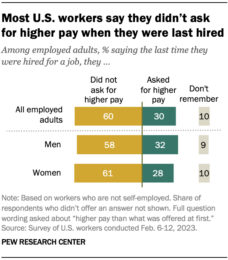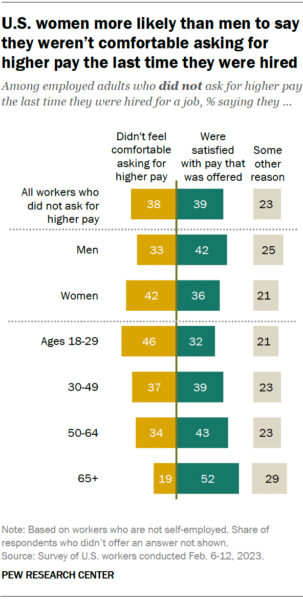When negotiating starting salaries, most U.S. women and men don’t ask for higher pay
April 21, 2023

By Kim Parker
The gender pay gap in the United States is sometimes linked to differences in the way women and men approach negotiating their pay. Most U.S. workers who are not self-employed say they did not ask for higher pay than what was initially offered the last time they were hired for a job, according to a new Pew Research Center survey. But men are slightly more likely than women (32% vs. 28%) to say they did ask for higher pay than what was offered.
 A bar chart showing that most U.S. workers didn’t ask for higher pay when they were hired last.
A bar chart showing that most U.S. workers didn’t ask for higher pay when they were hired last.
Among workers who did ask for higher pay, 28% say they were given the pay they asked for, 38% say they were given more than was originally offered but less than they had asked for, and 35% say they were only given what was first offered. Women are more likely than men (38% vs. 31%) to say that after asking for higher pay, they were only given what had initially been offered.
Gender differences also emerge when workers who didn’t negotiate for more pay are asked why not. Overall, 39% of workers who didn’t ask for higher pay say they were satisfied with the pay that was offered. A similar share (38%) say they didn’t feel comfortable asking for higher pay, and 23% say there was some other reason.
A chart showing that U.S. women were more likely than men to say they weren’t comfortable asking for higher pay.
 Men are more likely than women to say they were satisfied with the pay they were initially offered (42% vs. 36%), while women are more likely than men to say they didn’t feel comfortable asking for higher pay (42% vs. 33%).
Men are more likely than women to say they were satisfied with the pay they were initially offered (42% vs. 36%), while women are more likely than men to say they didn’t feel comfortable asking for higher pay (42% vs. 33%).
There are also large differences by age. Younger workers who didn’t ask for more money during their last hiring are the most likely to say they didn’t feel comfortable asking for higher pay. Some 46% of those ages 18 to 29 say this, compared with 37% of those ages 30 to 49, 34% of those 50 to 64 and only 19% of those 65 and older.
Note: Here are the questions used for this analysis, along with responses, and the survey’s methodology.





























